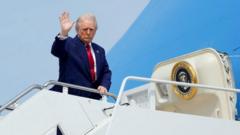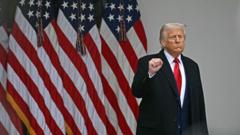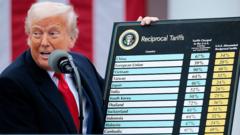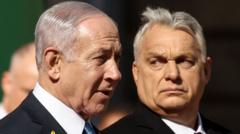President Trump’s return has brought a tumultuous phase to US-Russian relations that oscillate between attempts at diplomacy and confrontational remarks. Current developments indicate a complex interplay of negotiations, threats, and international scrutiny, underscoring the uncertainty of future collaborations.
Rollercoaster Relations: Trump and Putin on the US-Russia Diplomatic Thrill Ride

Rollercoaster Relations: Trump and Putin on the US-Russia Diplomatic Thrill Ride
Steve Rosenberg analyzes the fluctuating dynamics of US-Russia relations, highlighting recent tensions and potential shifts under President Trump's administration.
In a world where the twists and turns of international diplomacy resemble a rollercoaster, the evolving relationship between the United States and Russia under President Donald Trump is no exception. Just imagine a Russian language lesson for 2025, beginning with the phrase for “rollercoaster,” or “Amerikanskiye gorki,” to succinctly capture the erratic nature of U.S.-Russia interactions today.
Since Trump took office in January, his intent seemed clear: to mend ties with Russia. High-profile calls between Trump and Putin, as well as significant US-Russia negotiations, were notable. At one point, Washington even aligned with Moscow in opposing a UN resolution that condemned Russia as an aggressor in its ongoing conflict with Ukraine. Throughout these developments, pressure exerted by the Trump administration was largely directed at Ukraine rather than at Russia.
However, this diplomatic thrill ride took a sharp turn just days ago. Tensions flared when Putin suggested a "change of governance" in Ukraine, prompting an irritated Trump to express disappointment. After golfing together, Finnish President Alexander Stubb remarked that both America and Trump appeared to be losing patience with Russia's maneuvers.
With this growing impatience, Trump threatened to levy steep tariffs on Russian oil exports if Russia continued to stall peace efforts regarding Ukraine. A bi-partisan group of U.S. senators proposed heightened tariffs, even as the Russian press had previously welcomed the thaw in relations, declaring that officials from both nations were "finally speaking the same language." Yet, sharp criticism has emerged from Russian media in recent days, calling Trump’s administration “immature” and quick to boast about progress that remains tenuous.
Despite the harsh rhetoric, it was noteworthy that Trump's recently announced tariffs did not target Russia, and sanctions waivers were reportedly provided to a key Kremlin official, signaling some level of ongoing collaboration. However, Washington’s warnings have intensified. Secretary of State Marco Rubio declared that Trump will avoid the “trap of endless negotiations,” emphasizing the need for Russia to demonstrate seriousness for peace in the near future.
Complaints from NATO allies have added to the chorus of voices cautioning against trusting Putin’s intentions, as UK Foreign Secretary David Lammy critiqued Russia for continuing its bombardments in Ukraine while dragging its feet on talks. This stark reality existed alongside speculation about another potential phone conversation between Trump and Putin, which later appeared to have been called off.
As reports surface about American businesses contemplating participation in the upcoming St. Petersburg Economic Forum, one can’t help but feel dizzy from the rapid oscillations in U.S.-Russia relations. Observing from afar may be the best strategy at this point, unveiling the underlying question: can Trump's administration navigate these tumultuous waters to push for an end to the war, or is the Kremlin unyielding to external pressures? As the world watches closely, the uncertainty of these unfolding events looms larger than ever.






















